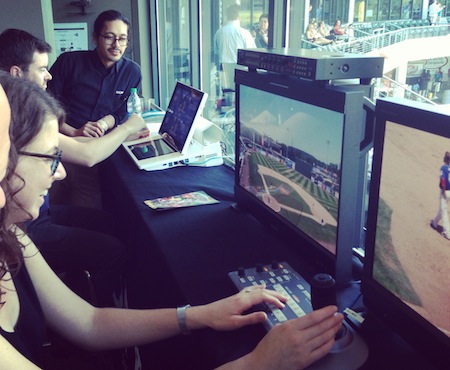Sony Simplifies Live Production with Anycast Touch, IP55

The battle over coax versus IP LAN cable connection was at the forefront of a recent Sony product demo event showcasing the NXL-IP55 live production transmission unit, along with the brand new Anycast Touch live content producer.
- After a few basic product demos at Sony’s headquarters in Park Ridge, New Jersey, attending press and Sony staff headed over to nearby Provident Bank Park to experience the live event system in action during a Rockland Boulders’ minor league baseball game.
- While acknowledging that coax connection is the best solution in many installations for broadcast and live production applications, IP-connection offers a much simpler yet highly effective implementation.
- The Anycast is a legacy product of Sony’s, which was recently updated with an all-encompassing touchscreen technology. Multiple elements of live production can be contained in this compact unit. This is especially useful for the HOW market, where many volunteers without much production experience step up to manage the systems, as well as corporate environments for seminars, education, and other live events. The portable system is most noted for its versatility, and ease of use, which Sony demonstrated in action at the Boulder’s game, allowing each member of the press to produce an inning of the game.
- With zero experience in a production environment, I was a bit nervous to give live production a try. But as soon as I sat down in front of the sleek touch interface, I felt a bit silly for holding any inhibition. The Anycast system was beyond simple to use. Switching between camera views with a tap on the screen, navigating between different views, adding text, and operating scenes was practically like navigating between different apps on my iPhone. It was highly intuitive and streamlined.
- But beyond production novices like myself, I asked Sony product manager Deon LeCointe what it would be like for integrators to install. Since the Anycast is an all-in-one switching solution, he explained, complete with audio mixer, streaming encoder and recording, camera control, etc., it cuts out having to keep a frame in a rack room separate from the control panel in a control room and having to connect the two.
- “At the end of the day,” LeCointe continued, “if you’re going to use the Anycast system in a fixed install, or you’re going to use it for portable move around, think of what you would have to do in the way of having to carry a video switcher, an audio mixer, a streaming encoder, a camera controller, all those different elements, if you have to move that in a portable space, it’d be a pain, especially tearing it down and setting it up. If you’re doing it in a permanent install, think of all the space that would take up. So from an Anycast perspective, once you plug in your signals, and you plug in your audio and video and you plug in your internet connection, you’re done.”
- Here are a couple of pictures of the Anycast Touch.
The IP55, which has been shipping since January, was also touted for its simple use and installation, particularly in the programming phase, due to a handy web interface that’s installed. So once camera signals are connected on one end and audio signals are connected, and the output of the receiver is connected to the switcher, the web interface does the rest. “You literally go in and tell this that it’s a transmitter, that’s transmitting this many signals, and this is a receiver, that’s receiving this many signals. And that’s it,” LeCointe described. “It can all be done over the network, via the web interface. It can all be done via a switch. So even if you have one at this side of the stadium and one at this side of the stadium, if they’re on the same network, you can talk to both at the same time.”Here’s me in action working the IP55 at the Rockland Boulder’s game.

The IP55 has already been installed in a number of facilities in Europe, two in the Middle East, some in South America, and some others in Asia. While there have been a number of successful tests of the live production transmission unit in the U.S., there aren’t any completed installations yet. Sony continues to educate many of its U.S. customers on the merits of using IP versus coax. LeCointe chalks this up to the varying nature of the markets in those other areas, where there are many government subsidies for broadcasters, which differs greatly from the U.S. broadcast market. “It takes a little bit more time, at least for the budget cycles, for these guys to catch on versus what those guys in different markets, in other countries can do,” he said.
Meanwhile, the Anycast Touch system is scheduled to ship in September. Sony is busily working to have CAD drawings available for the Anycast Touch on its consultant and systems integrator website, so integrators will soon be able to start spec’ing the Anycast Touch in. “Of course, it’s first come first serve, so if they want to preorder, that’s always a good idea,” LeCointe noted.
Integrators can’t do too much yet without the CAD drawings or the manual, “but there’s a lot of buzz around it,” LeCointe asserted. “Since we showed it at NAB, I can barely keep my demo units in New Jersey. The fact that I have two here is a miracle.”
Watch LeCointe talk about the Anycast Touch here.
A daily selection of features, industry news, and analysis for AV/IT professionals. Sign up below.
Lindsey M. Adler is an audiovisual storyteller based in New York.

